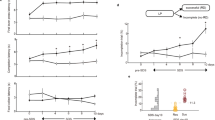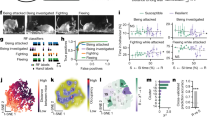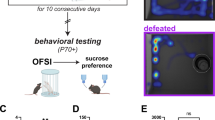Abstract
Persistence is the propensity to maintain goal-directed actions despite adversities. While this temperamental trait is crucial to mitigate depression risk, its neurobiological foundations remain elusive. Developing behavioral tasks to capture persistence in animal models is crucial for understanding its molecular underpinnings. Here, we introduce the Sinking Platform Test (SPT), a novel high-throughput paradigm to measure persistence. Mice were trained to exit a water-filled tank by ascending onto a platform above water level. Throughout the training, mice were also occasionally exposed to “failure trials,” during which an operator would submerge a platform right after the mouse climbed onto it, requiring the mouse to reach and ascend a newly introduced platform. Following training, mice were subjected to a 5-min test exclusively consisting of failure trials. Male and female mice exhibited comparable persistence, measured by the number of climbed platforms during the test. Furthermore, this index was increased by chronic administration of fluoxetine or imipramine; conversely, it was reduced by acute and chronic haloperidol. Notably, six weeks of social isolation reduced SPT performance, and this effect was rescued by imipramine treatment over the last two weeks. A 4-week regimen of voluntary wheel running also improved persistence in socially isolated mice. Finally, comparing transcriptomic profiles of the prefrontal cortex of mice with high and low SPT performance revealed significant enrichment of immediate-early genes known to shape susceptibility for chronic stress. These findings highlight the potential of SPT as a promising method to uncover the biological mechanisms of persistence and evaluate novel interventions to enhance this response.
This is a preview of subscription content, access via your institution
Access options
Subscribe to this journal
Receive 13 print issues and online access
$259.00 per year
only $19.92 per issue
Buy this article
- Purchase on Springer Link
- Instant access to full article PDF
Prices may be subject to local taxes which are calculated during checkout





Similar content being viewed by others
References
Van Doren N, Tharp JA, Johnson SL, Staudenmaier PJ, Anderson C, Freeman MA. Perseverance of effort is related to lower depressive symptoms via authentic pride and perceived power. Personal Individ Differ. 2019;137:45–49.
Wrosch C, Heckhausen J, Lachman ME. Primary and secondary control strategies for managing health and financial stress across adulthood. Psychol Aging. 2000;15:387–99.
Zainal NH, Newman MG. Relation between cognitive and behavioral strategies and future change in common mental health problems across 18 years. J Abnorm Psychol. 2019;128:295–304.
Feather NT. The study of persistence. Psychol Bull. 1962;59:94–115.
Duckworth AL, Peterson C, Matthews MD, Kelly DR. Grit: perseverance and passion for long-term goals. J Pers Soc Psychol. 2007;92:1087–101.
Baum JR, Locke EA. The relationship of entrepreneurial traits, skill, and motivation to subsequent venture growth. J Appl Psychol. 2004;89:587–98.
McCormick A, Meijen C, Marcora S. Psychological determinants of whole-body endurance performance. Sports Med Auckl NZ. 2015;45:997–1015.
Cloninger CR, Svrakic DM, Przybeck TR. A psychobiological model of temperament and character. Arch Gen Psychiatry. 1993;50:975–90.
Gusnard DA, Ollinger JM, Shulman GL, Cloninger CR, Price JL, Van Essen DC, et al. Persistence and brain circuitry. Proc Natl Acad Sci USA. 2003;100:3479–84.
McGuire JT, Kable JW. Medial prefrontal cortical activity reflects dynamic re-evaluation during voluntary persistence. Nat Neurosci. 2015;18:760–6.
Müller EJ, Munn B, Mohr H, Ruge H, Shine JM. Brain state kinematics and the trajectory of task performance improvement. NeuroImage. 2021;243:118510.
Radley JJ, Rocher AB, Miller M, Janssen WGM, Liston C, Hof PR, et al. Repeated stress induces dendritic spine loss in the rat medial prefrontal cortex. Cereb Cortex N Y N 1991. 2006;16:313–20.
Jakobsen IS, Madsen LMR, Mau M, Hjemdal O, Friborg O. The relationship between resilience and loneliness elucidated by a Danish version of the resilience scale for adults. BMC Psychol. 2020;8:131.
North TC, McCullagh P, Tran ZV. Effect of exercise on depression. Exerc Sport Sci Rev. 1990;18:379–415.
Peluso MAM, Guerra de Andrade LHS. Physical activity and mental health: the association between exercise and mood. Clin Sao Paulo Braz. 2005;60:61–70.
Roberts DCS, Richardson NR. Self-administration of psychomotor stimulants using progressive ratio schedules of reinforcement. In: Boulton AA, Baker GB, Wu PH, editors. Anim. Models Drug Addict., Totowa, NJ: Humana Press; 1992. p. 233-69.
Wu YE, Pan L, Zuo Y, Li X, Hong W. Detecting activated cell populations using single-cell RNA-Seq. Neuron. 2017;96:313–329.e6.
Gururajan A. The impact of chronic stress on the PFC transcriptome: a bioinformatic meta-analysis of publicly available RNA-sequencing datasets. Stress Amst Neth. 2022;25:305–12.
Floresco SB, Tse MTL, Ghods-Sharifi S. Dopaminergic and glutamatergic regulation of effort- and delay-based decision making. Neuropsychopharmacol Off Publ Am Coll Neuropsychopharmacol. 2008;33:1966–79.
Porter B, Hillman KL. A novel weight lifting task for investigating effort and persistence in rats. Front Behav Neurosci. 2019;13:275.
Christensen R, Knezek G. Comparative measures of grit, tenacity and perseverance. Int J Learn Teach Educ Res. 2014;8:16–30.
Lewis CA, Grahlow M, Kühnel A, Derntl B, Kroemer NB. Women compared with men work harder for small rewards. Sci Rep. 2023;13:5456.
Le Mat F, Géry M, Besson T, Ferdynus C, Bouscaren N, Millet GY. Running endurance in women compared to men: retrospective analysis of matched real-world big data. Sports Med Auckl NZ. 2023;53:917–26.
Bogdanova OV, Kanekar S, D’Anci KE, Renshaw PF. Factors influencing behavior in the forced swim test. Physiol Behav. 2013;118:227–39.
Lee SE, Park S-H, Aldrich JC, Fonken LK, Gaudet AD. Anxiety-like behaviors in mice unmasked: Revealing sex differences in anxiety using a novel light-heat conflict test. Biorxiv. https://doi.org/10.1101/2022.09.02.506410
Commons KG, Cholanians AB, Babb JA, Ehlinger DG. The Rodent forced swim test measures stress-coping strategy, not depression-like behavior. ACS Chem Neurosci. 2017;8:955–60.
Reardon S. Depression researchers rethink popular mouse swim tests. Nature. 2019;571:456–7.
Ieraci A, Mallei A, Popoli M. Social isolation stress induces anxious-depressive-like behavior and alterations of neuroplasticity-related genes in adult male mice. Neural Plast. 2016;2016:6212983.
Arida RM, Teixeira-Machado L. The contribution of physical exercise to brain resilience. Front Behav Neurosci. 2020;14:626769.
Belcher BR, Zink J, Azad A, Campbell CE, Chakravartti SP, Herting MM. The roles of physical activity, exercise, and fitness in promoting resilience during adolescence: effects on mental well-being and brain development. Biol Psychiatry Cogn Neurosci Neuroimaging. 2021;6:225–37.
Dulawa SC, Holick KA, Gundersen B, Hen R. Effects of chronic fluoxetine in animal models of anxiety and depression. Neuropsychopharmacol Off Publ Am Coll Neuropsychopharmacol. 2004;29:1321–30.
Benfato ID, Quintanilha ACS, Henrique JS, Souza MA, Rosário BDA, Beserra Filho JIA, et al. Effects of long-term social isolation on central, behavioural and metabolic parameters in middle-aged mice. Behav Brain Res. 2022;417:113630.
Kim YJ, Kim HJ, Lee WJ, Seong JK. A comparison of the metabolic effects of treadmill and wheel running exercise in mouse model. Lab Anim Res. 2020;36:3.
Hill BD, Aita SL. The positive side of effort: A review of the impact of motivation and engagement on neuropsychological performance. Appl Neuropsychol Adult. 2018;25:312–7.
Verweij KJH, Zietsch BP, Medland SE, Gordon SD, Benyamin B, Nyholt DR, et al. A genome-wide association study of Cloninger’s temperament scales: implications for the evolutionary genetics of personality. Biol Psychol. 2010;85:306–17.
Okuno H. Regulation and function of immediate-early genes in the brain: beyond neuronal activity markers. Neurosci Res. 2011;69:175–86.
Pérez-Cadahía B, Drobic B, Davie JR. Activation and function of immediate-early genes in the nervous system. Biochem Cell Biol Biochim Biol Cell. 2011;89:61–73.
Styk W, Klinkosz W. the maze test: a computer tool for testing perseverance. Psychol Res Behav Manag. 2020;13:1277–88.
Duckworth AL, Quinn PD. Development and validation of the short grit scale (grit-s). J Pers Assess. 2009;91:166–74.
Cairns KE, Yap MBH, Pilkington PD, Jorm AF. Risk and protective factors for depression that adolescents can modify: a systematic review and meta-analysis of longitudinal studies. J Affect Disord. 2014;169:61–75.
Breton J-J, Labelle R, Berthiaume C, Royer C, St-Georges M, Ricard D, et al. Protective factors against depression and suicidal behaviour in adolescence. Can J Psychiatry Rev Can Psychiatr. 2015;60:S5–S15.
Dooley B, Fitzgerald A, Giollabhui NM. The risk and protective factors associated with depression and anxiety in a national sample of Irish adolescents. Ir J Psychol Med. 2015;32:93–105.
Southwick SM, Charney DS. The science of resilience: implications for the prevention and treatment of depression. Science. 2012;338:79–82.
Southwick SM, Bonanno GA, Masten AS, Panter-Brick C, Yehuda R. Resilience definitions, theory, and challenges: interdisciplinary perspectives. Eur J Psychotraumatology. 2014;5:25338.
Acknowledgements
We thank William O Wright IV, Hunter Strathman, Karen Odeh, Easton vanLuik, Conor Craig, Yingduo Yang, and Amanda Wall for their technical assistance with animal testing. We thank Dr. Caterina Branca for her precious editorial assistance and suggestions.
Funding
This study was partially supported by the NIH grants R01 MH104603 and R56 MH130006 (to MB).
Author information
Authors and Affiliations
Contributions
Gabriele Floris: Behavioral and pharmacological investigation, Conceptualization of Experimental design, Formal analysis, Writing – original draft, Writing – review & editing. Sean C Godar: Behavioral and pharmacological investigation; Conceptualization of Methodology. Giulia Braccagni: Behavioral and pharmacological investigation. Ignazio S Piras: Bioinformatic analysis; Writing – review & editing. Alicia Ravens: Behavioral investigation. Mary T Zanda: Formal analysis. Matthew J Huentelman: Bioinformatic analysis. Writing – review & editing. Marco Bortolato: Conceptualization and Development of Methodology and Experimental design, Data curation, Writing – original draft, Writing – review & editing, Funding acquisition.
Corresponding author
Ethics declarations
Competing interests
MB consults for Asarina Pharmaceuticals and receives research funding from Asarina and Lundbeck Pharmaceuticals. The other authors declare no conflict of interest.
Additional information
Publisher’s note Springer Nature remains neutral with regard to jurisdictional claims in published maps and institutional affiliations.
Supplementary information
Rights and permissions
Springer Nature or its licensor (e.g. a society or other partner) holds exclusive rights to this article under a publishing agreement with the author(s) or other rightsholder(s); author self-archiving of the accepted manuscript version of this article is solely governed by the terms of such publishing agreement and applicable law.
About this article
Cite this article
Floris, G., Godar, S.C., Braccagni, G. et al. The sinking platform test: a novel paradigm to measure persistence in animal models. Neuropsychopharmacol. (2024). https://doi.org/10.1038/s41386-024-01827-0
Received:
Revised:
Accepted:
Published:
DOI: https://doi.org/10.1038/s41386-024-01827-0



